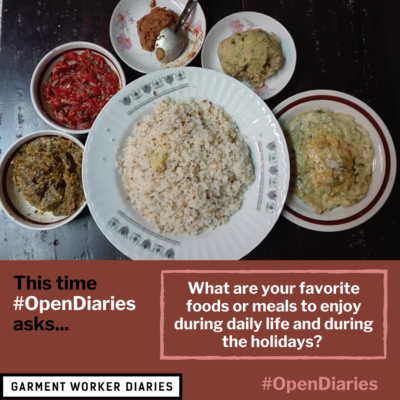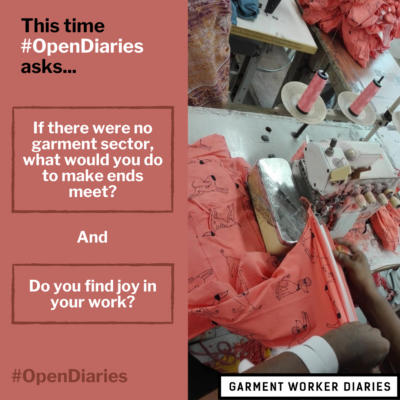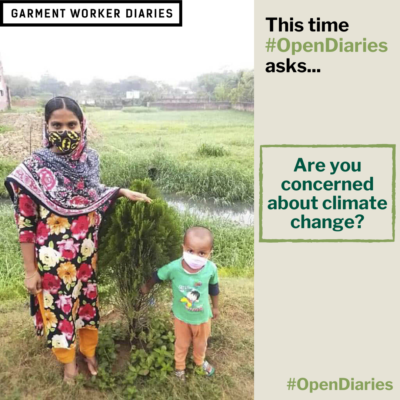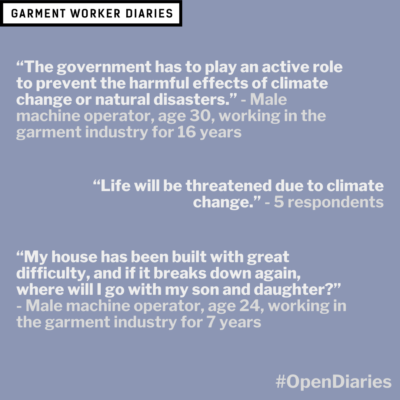This week’s Garment Worker Diaries blog has been guest-written by MFO’s communications intern, Evey Gutierrez. Evey shares with us what she has learned from conducting outreach to garment industry stakeholders and managing the #OpenDiaries social media campaign. In case you haven’t seen the most recent #OpenDiaries post, you can view it and all the rest of our #OpenDiaries posts and infographics by following our Worker Diaries Instagram page.
Note: Above are some of my favorite #OpenDiaries title slides that we curated with content shared directly with us by garment workers in Bangladesh.
For the past year, I have had the privilege of interning with Microfinance Opportunities (MFO) as an outreach and communications coordinator and as the co-manager of the organization’s first social media campaign, #OpenDiaries. My assignment originally involved finding and contacting university groups devoted to labor rights. This later turned into a different undertaking to share MFO and (their partner in the field) SANEM’s research with a wider audience via social media. During the first four months of my internship, I compiled lists of university groups, social media accounts, and organizations dedicated to international labor rights. My aim in emailing these stakeholders was to forge relationships between them and MFO, to share our public data with them, and to collect questions from them about our work and about our garment worker participants. I discovered that this pursuit for inter-organizational collaboration was difficult. It was exciting to connect with the Worker Rights Consortium in July of 2020, and to open a line of communication with them to collaborate and contribute to their various projects. When it came to reaching university groups, however, I did not have much luck. With the academic interruptions caused by the pandemic, this was not wholly unexpected.
Because my emailing and social media outreach to several groups were not prompting frequent responses, the team began to consider new ways to attract an audience and gain an online presence. It was of particular importance that we create something accessible to consumers and industry stakeholders that would speak to them in a unique way, different from our typical data-centric reporting. I suggested in our staff meeting that we capitalize on our Special Questions section of the Garment Worker Diaries (GWD) weekly survey, and gather questions from social media users, family members, and friends about life as a garment worker. The following week, the team came prepared with questions to vote on for the next survey and we discussed the logistics of obtaining visual content from the field. Given the limitations presented by COVID-19, we decided to try out something that had not been attempted before at MFO: to ask the worker leaders who had access to phone cameras to photograph elements of their lives for the world to see. We provided a photo prompt that corresponded with the special questions for the weekly survey, such as “free-time activities” and “pictures of your favorite meal,” and emphasized participant consent and safety in our communication. In early November, we published MFO’s first #OpenDiaries post to all of our social media pages.
Through curating 15 #OpenDiaries posts over the past eight months, I came to realize that, at its heart, #OpenDiaries is a photojournalism project that overcomes the obstacles created by the COVID-19 pandemic. While hiring a photographer in the field would have made the social media posts more professional and aesthetically uniform, the pandemic forced us to consider having workers capture their own images to share with us. What resulted was an intimate and personalized look at garment workers’ communities, homes, and environments. The teams at MFO and SANEM as well as the Bangladeshi respondents have had the opportunity to dialogue with one another on diverse topics such as climate change, travel aspirations, and work benefits, among others. The photojournalism products, both imagery and stories, are in the hands of the subjects, our garment worker respondents. While I curate the posts, from the images and responses sent to us, the Bangladeshi workers provide the content for the world (or at least our followers) to see.
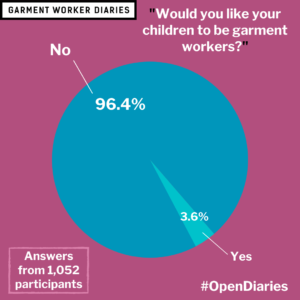

Note: For me, the above pie chart represents one of the most poignant data findings the #OpenDiaries campaign revealed.
The #OpenDiaries project is both innovative and creative, but the difficulties of engaging users with this work persist. While many important campaigns devoted to garment industry awareness and activism feature a central call to action for their viewers, #OpenDiaries carefully and intentionally presents worker stories and their own calls for change—from increased and punctually-paid wages to sick leave benefits. The campaign is vital in the broader conversation of garment workers’ rights and increasing sustainability—specifically related to the health, education, and quality of life of Bangladeshi garment workers. Through their own storytelling, GWD participants share with the world their perspectives from within a troubling garment industry. A listening and concerned audience will be critical to its transformation.
Note: Above are some of my favorite images garment workers shared with us, as well as some of my favorite quotes in response to our question prompts.

